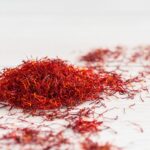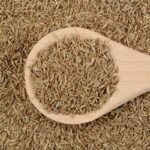Quick summary: Annatto, ginger, paprika, or saffron might be the best substitutes for turmeric. But curry, mustard seeds, cumin, and other replacements can also help you.
Turmeric is best known for the bold yellow color it brings to dishes. From rice and curry to soups and sauces, this unique plant root has been used in Asia for thousands of years.
If your recipe calls for turmeric and it’s not something you generally keep at home (or have run out of), there are some other ingredients you can easily grab as a turmeric substitute.
The ingredients you choose will depend on whether you’re after the color, turmeric taste, or require both for your dish.
In this guide, we’ll help you pick the perfect substitute for turmeric according to the recipe you are preparing.
What Is Turmeric?
Turmeric is part of the ginger family and has a very similar appearance to ginger root. The main difference is that turmeric has bright orange flesh as opposed to the light yellow color of ginger. The rhizomes are grown largely in India and Southeast Asia.
Besides being used in cooking, the root is also well regarded for its health and anti-inflammatory properties and is used as a dye.
When working with fresh turmeric, you’ll want to be careful as the vibrant color can stain your clothes and hands, very much like beetroot would. Turmeric powder is easier to work with than the fresh root since you don’t have to handle it with your hands.
The spice has a very earthy taste with bitterness, a slight pepperiness, and a hint of ginger. It is rarely used as a prominent flavor in a dish but rather as a coloring agent and to blend with other spices.
It is a key ingredient in yellow curries and is also used in Thai cuisine, rice dishes, noodles, soups, and in preparing meat, seafood, and vegetables.
Fresh Turmeric Root vs Powder Turmeric
Powdered turmeric can be found in the spice aisle of most grocery stores. The powder is simply the fresh root dried and finely ground.
Fresh and ground turmeric can be used interchangeably. Half an inch of the fresh version equals one teaspoon of the yellow powder.
The powder has an intensified taste. Start with just a small amount of the powder when replacing it for a fresh root. Slowly add more if needed. Stir and taste before adding more to prevent throwing off the flavor (and color) balance of your dish.
Alternatively, you can also use turmeric paste, although this may be harder to find.
Best Turmeric Substitutes
# 1. Annatto
Annatto seeds are seeds from South American achiote trees. They vary from yellow and red to orange and have an earthy flavor with sweet and peppery notes. The seeds are used as a natural food coloring in sauces, pasta, and rice.
Besides being available as whole seeds, Annatto also comes in a powder and paste form. To use the seeds, either grind them into a powder or steep them in warm liquid before using.
You can do this by adding one teaspoon of seeds to a quarter cup of hot water or milk. Let it sit for a few minutes. Once you are happy with the strength, strain out the seeds.
Use only the liquid extract for cooking. Keep in mind that you will have to reduce liquid elsewhere in the recipe to prevent changes in consistency.
You can also fry the seeds in a neutral vegetable oil such as canola, sunflower, or safflower oil. Strain the seeds off and use the oil in your recipe.
If you are using annatto paste, thin it out with a small amount of water before adding it to the dish. The paste is stronger than soaking the seeds, so use it in small amounts.
Ground or powdered annatto seeds can be used in the same way you would use any other spice by simply mixing it into your dish during cooking.
Annatto goes well with many dishes, including chicken and pork recipes, spice rubs, marinades, sauces, and stews. It can also be used for coloring the dough of savory baked goods or yellow rice.
# 2. Saffron
Saffron comes from the flowers of the crocus sativus plant. Each flower yields only three stigmas that are dried as saffron. Since it takes 75 000 handpicked blossoms to yield only 450 grams of saffron, it is one of the most expensive spices.
It gives off a similar color to turmeric, which makes it one of the closest matching substitutes. The spice is very fragrant, with a floral, earthy, sweet, and slightly bitter taste. It has a sweeter taste than turmeric, so be aware of this when using it as a replacement.
It is ideal for Persian, Indian, European, and Mediterranean dishes. The spice is used for chicken, pork, paella, spice rubs, rice, marinades, sauces, stews, and tinting dough.
As a guideline, use three strands of saffron for each serving or person you are cooking for. Therefore, if you are cooking for three people, using only nine strands in your entire dish will be enough.
# 3. Fresh Ginger
You can use fresh ginger root as a substitute for fresh turmeric. Since they are from the same plant family, they have similar flavor notes. Ginger is, however, less bitter with a stronger bite. Ginger will also not give you the same yellow color.
Since ginger is punchier, use a little less in your dish. It is delicious in a variety of dishes, including curry, soup, stir-fries, stew, marinades, and sauces.
If you spent only a part of it for one meal, learn how to freeze ginger and preserve it for future dishes.
# 4. Ground Ginger
In the same way that you can use fresh ginger, you can also use ground ginger or ginger powder to substitute turmeric powder. Use only half the amount called for in your recipe since it does have a stronger flavor.
# 5. Paprika
Paprika is something you likely already have in the pantry. The great thing with this substitute is that you can use any type of paprika according to your preference.
Of course, the type you use will influence the taste of your dish. If you don’t like spice, sweet paprika is a better choice than hot paprika. You can also use smoked paprika to add flavor.
Smoked paprika is good with meaty dishes and stews, while hot paprika is ideal for curries. Keep in mind that paprika is red rather than yellow.
# 6. Madras Curry Powder
Madras curry powder is a good substitute in Indian and rice dishes but won’t work as well in other cuisine types.
The curry spice blend generally includes cumin, chili, fenugreek, and turmeric. It will give a similar (but slightly darker) color, increased spiciness, and more depth.
When using a spice blend like Madras curry powder as a replacement, you can use it to replace more than one spice at a time.
For example, if your recipe calls for turmeric and cumin, you can use curry powder as a replacement for both ingredients. Using the curry powder and adding cumin again separately will throw out the balance of flavors.
Since it contains turmeric, you will get a similar color; however, some curry powders are more orange or red. Essentially the type of curry powder you have will influence how dark your dish turns out as well as how spicy it is.
One important thing to keep in mind when using curry powder as a substitute is that it has a much bolder flavor profile. If you add too much, you can instantly change the entire flavor profile of your dish. Use it sparingly and add a little at a time if more is needed.
# 7. Garam Masala
Garam Masala is another spice combination often used in curries and Indian cuisine.
The blend generally contains cumin, cardamom, clove, cinnamon, and black pepper. Some versions also include mace and mustard seeds. The blend is rich and spicy, so only use half the amount required in your recipe.
As with Madras curry powder, you can use the blend to replace numerous spices simultaneously. It is best used in Indian recipes.
# 8. Yellow Mustard Seeds or Mustard Powder
Yellow mustard seeds are a spice and are different from the condiment. The condiment will not be suitable as a replacement so ensure you only use the seeds, dry mustard, or mustard powder.
Mustard seeds have a slightly different taste with a bit of sweetness and spiciness. It will give your dish a similar yellow color and is great to use in potato and legume dishes, chicken, seafood, sauces, rubs, marinades, and curries.
# 9. Mace And Smoked Paprika
You can combine mace and smoked paprika for a wonderful versatile alternative.
Mace is the outer membrane of nutmeg seeds. Combining it with smoked paprika will give your dish a deeper color, sweet, and spicy flavor. It is great for a wide variety of savory dishes, including meat, stew, and seafood.
We recommend you start with just a small amount, as it can be overpowering.
# 10. Cumin Seeds
Although cumin is not quite as good a substitute as annatto or saffron, you are probably more likely to have this option in the pantry. It won’t give you the same bright yellow color, but it does have a similar (yet slightly stronger) earthy taste.
This is a good turmeric substitute in curries, rice dishes, potato dishes, and stews. You can also combine it with a little galangal for an authentic kick.
If you don’t have the seeds but have ground cumin or cumin powder, these will work just as well. Start with a little less than the recipe requires and add to taste if needed.
# 11. Galangal Powder
Galangal is also from the ginger family and looks like a lighter form of ginger root. As with ginger and turmeric powder, galangal powder is the dried root, ground up finely.
Galangal has a sharp flavor with citrus and pine notes. It is best used in South Asian dishes or Indian recipes and won’t pair well with European or Mediterranean classics. This spice also won’t give you the yellow color, so if that is vital to your dish, opt for a different replacement.
The powder version is more concentrated than the fresh, so start with a very small amount and add little bits at a time if you require more intensity.
FAQ
This spice works well with rice, quinoa, couscous, and bulgur wheat. It is also a great addition to soups, stews, roasted vegetables, and bean dishes.
Once the root is cut or broken, it should be wrapped to protect it from contact with air and stored in the fridge. Leaving it out of the fridge or uncovered will cause it to dry out and shrivel.
Yes, if you grate and freeze turmeric in airtight zip-top bags, it can last for up to six months in the freezer.
Conclusion
Turmeric is an interesting spice that is largely used for the color it brings to dishes. Matching the flavor exactly is very hard, but since it is often mixed with other spices, you can create similar flavor notes when choosing carefully.
The two closest matches for the same color and flavor are annatto and saffron. These can be used in almost any savory dish. Curry powders are best saved for Indian cuisine, while galangal and ginger pair well with Asian dishes.
Most of the spices suitable as substitutes have a strong flavor and can easily overtake your dish in an unpleasant way if not used with caution.
With the above turmeric replacement options, it is advised to start with a little less than your recipe calls for. If needed, add more in small amounts as you continue to stir and taste. Give the spices a little time to infuse evenly into the dish before making adjustments.
Happy cooking!
*image by Nikolay_Donetsk/depositphotos









